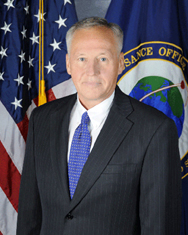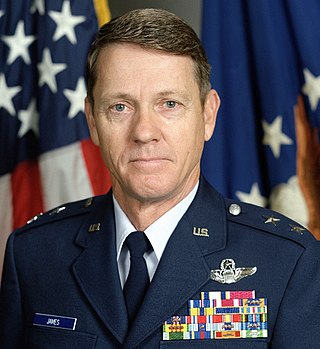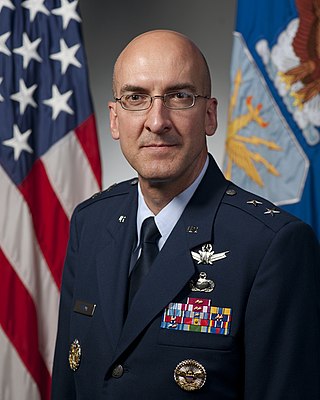
The National Geospatial-Intelligence Agency (NGA) is a combat support agency within the United States Department of Defense whose primary mission is collecting, analyzing, and distributing geospatial intelligence (GEOINT) in support of national security. Initially known as the National Imagery and Mapping Agency (NIMA) from 1996 to 2003, it is a member of the United States Intelligence Community.

James Arthur Williams was a United States Army lieutenant general. Williams served as Director of the Defense Intelligence Agency in the 1980s. He was a 1987 inductee of the Military Intelligence Hall of Fame and was the chairman of the board of directors for the National Military Intelligence Association.

Lieutenant General (Retired) Daniel P. "Fig" Leaf was Deputy Commander and Acting Commander, United States Pacific Command, Camp H. M. Smith, Hawaii.

Claude Robert "Bob" Kehler, is a retired United States Air Force general who served as Commander, United States Strategic Command from January 28, 2011 to November 15, 2013. He previously served as Commander, Air Force Space Command from October 12, 2007 to January 5, 2011. As commander of Air Force Space Command, he was responsible for the development, acquisition and operation of the Air Force's space and missile systems. He oversaw a global network of satellite command and control, communications, missile warning and launch facilities, and ensures the combat readiness of America's intercontinental ballistic missile force. He led more than 39,700 space professionals who provide combat forces and capabilities to North American Aerospace Defense Command and U.S. Strategic Command. He was also responsible for the plans and operations for all U.S. forces conducting strategic deterrence and Department of Defense space and cyberspace operations. He officially retired from the Air Force on January 1, 2014 after nearly 39 years of service.

General Lester L. Lyles is a retired four-star general in the United States Air Force (USAF). He served as Vice Chief of Staff of the United States Air Force, and Commander, Air Force Materiel Command, Wright-Patterson Air Force Base, Ohio. After retirement from the USAF in 2003, he became a company director for General Dynamics, DPL Inc., KBR, Inc., Precision Castparts Corp., MTC Technologies, Battelle Memorial Institute and USAA. Lyles is also a trustee of Analytic Services and a managing partner of Four Seasons Ventures, LLC.

Bruce Allen Carlson, was the 17th Director of the National Reconnaissance Office (NRO). He is a former four-star general in the United States Air Force and served as the sixth Commander, Air Force Materiel Command, Wright-Patterson Air Force Base, Ohio. The command conducts research, development, test and evaluation, and provides acquisition management services and logistics support necessary to keep Air Force weapon systems ready for war. After over 37 years of service, he retired from the Air Force on January 1, 2009. Carlson served as a general authority and a member of the Second Quorum of the Seventy of the Church of Jesus Christ of Latter-day Saints from April 2009 to October 2015.

General Lance W. Lord is a retired four-star general in the United States Air Force who served as Commander of Air Force Space Command at Peterson Air Force Base in Colorado.

Retired Maj. Gen. Roosevelt Mercer Jr., SES, is the director of the Interagency Planning Office (IPO) for the Next Generation Air Transportation System (NextGen) at the Federal Aviation Administration where he provides high-level leadership for interagency and international collaboration related to NextGen. He executes the collaborative processes needed to ensure efficient coordination among all federal partners whose decisions impact NextGen. The federal partner agencies include the National Aeronautics and Space Administration (NASA), Department of Defense (DoD), Department of Homeland Security (DHS), Department of Commerce (DOC), National Transportation Safety Board (NTSB), National Science Foundation (NSF), and Federal Aviation Administration (FAA), as well as the White House Office of Science and Technology Policy (OSTP) and the Office of the Director of National Intelligence (ODNI) as an ex officio participant. Mr. Mercer is charged with providing executive direction to a dynamic multi-agency and international partnering organization focused on future NextGen technology, policy, and collaborative activities.

Sandra E. Finan was the Deputy Chief Information Officer for Command, Control, Communications and Computers (C4) and Information Infrastructure Capabilities, Office of the Secretary of Defense, Pentagon, Washington D.C.

Major General William K. James of United States Air Force, was director of the Defense Mapping Agency (DMA) between June 1990 and June 1993. Under his leadership Major General James redirected the DMA – a heritage organization of the National Geospatial-Intelligence Agency – from producing products to meet the requirements of the Cold War to a concept of a Global Geospatial Information System (GGIS) directly accessible to combat commanders of the Rapid Deployment Forces. The GGIS was a major paradigm shift in warfare with the delivery of geographic information to fast-moving military forces.

Major General Philip William Nuber of United States Air Force, was director of the Defense Mapping Agency from December 1994 to May 1996.

Lieutenant General Abner Broadwater Martin was third Director of the United States Defense Mapping Agency from September 1977 to June 1979.

Space Operations Command (SpOC) is the United States Space Force's space operations, cyber operations, and intelligence field command. It is headquartered at Peterson Space Force Base, Colorado and serves as the U.S. Space Force's service component to United States Space Command. Space Operations Command consists of Space Operations Command West, its mission deltas, and garrison commands.

Christopher Stephen Povak is a United States Space Force major general who serves as the deputy director of the National Reconnaissance Office and commander of the Space Force Element to the National Reconnaissance Office. He previously served as the deputy director of the Space Warfighting Analysis Center.

Donald Jason Cothern is a brigadier general in the United States Space Force currently serving as the deputy commander of the Space Systems Command. He transferred to the Space Force from the United States Air Force in May 2021.

Douglas Andrew Schiess is a United States Space Force major general who serves as the commander of Combined Force Space Component Command and vice commander of Space Operations Command. He previously served as the deputy commanding general (operations) of the Space Operations Command. He has also commanded the 45th Space Wing, the 21st Space Wing, the 45th Operations Group, and the 4th Space Operations Squadron of the U.S. Air Force. In July 2021, Schiess was nominated for transfer to the United States Space Force and promotion to major general. Schiess transferred from the Air Force to the Space Force on April 28, 2022.

The United States Space Force is organized by different units: the Space Staff, the field commands, and the space deltas.

Troy Lynd Endicott is a United States Space Force brigadier general serving as the Assistant Deputy Chief of Space Operations for Operations, Cyber and Nuclear. Previously, he was the director for space policy at the United States National Security Council. Prior to that, he was the commander of the 460th Space Wing.

Steven P. Whitney is a United States Space Force major general who has served as the military deputy to the assistant secretary of the Air Force for space acquisition and integration since August 24, 2021. He is responsible for research and development, test, production, product support, and modernization of Space Force programs worth more than $15 billion annually. His responsibilities include crafting program strategies and options for representing Department of the Air Force positions to the Office of the Secretary of Defense, Congress and the White House.

Terrence (Terry) Feehan is a retired major general in the United States Air Force and was the Director of Strategic Plans and Requirements, Headquarters Air Force Space Command, Peterson Air Force Base, Colorado. In that role he was responsible for developing strategy, doctrine and policy for the command's space and cyberspace operations. After his military retirement, he became a vice president at Northrop Grumman where he directed a variety of staff functions and served as a major program director.




















